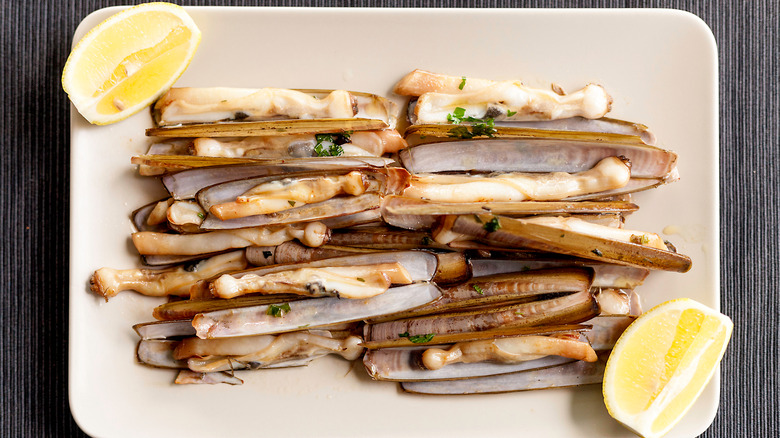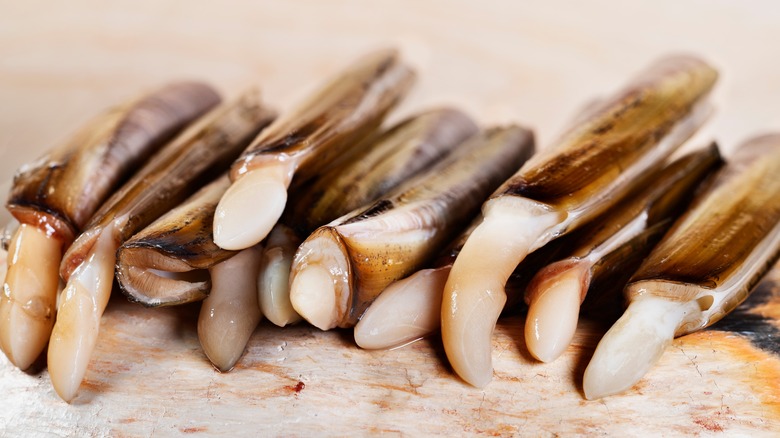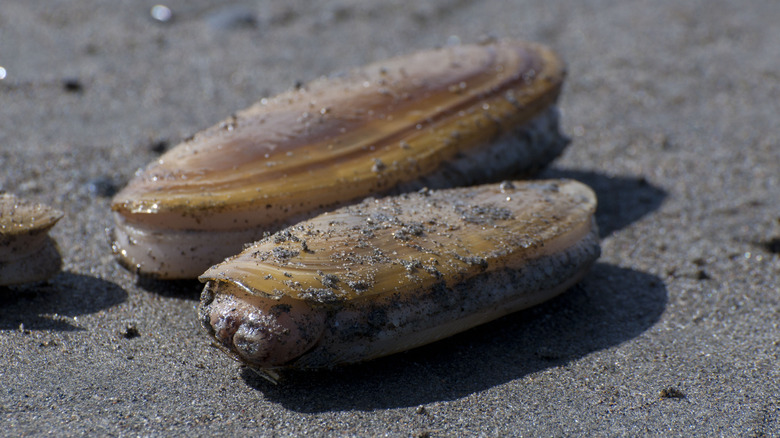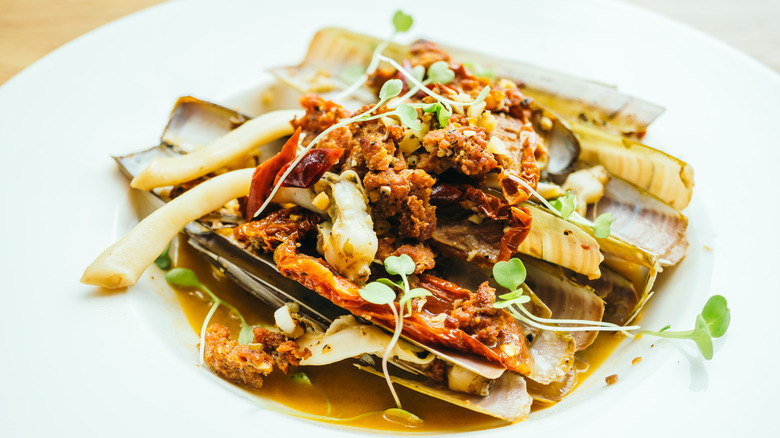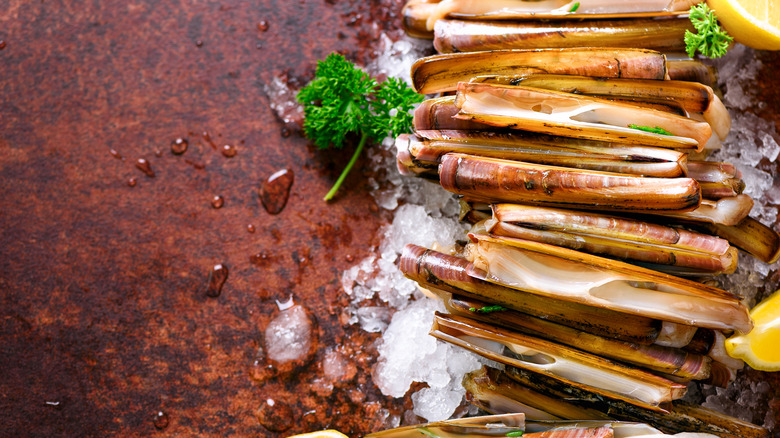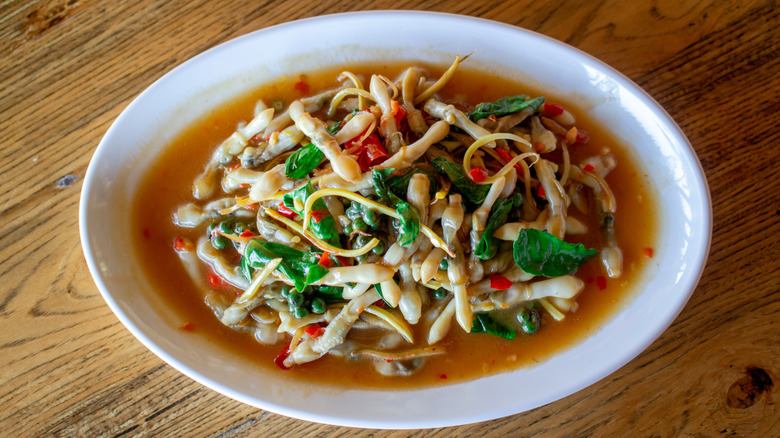What Makes Razor Clams Unique
Clams are often regarded as a delicacy, found in beachside seafood restaurants and upscale dining environments alike. According to MasterClass, there are roughly 150 types of clams that are suited for the dinner table, but there are few varieties that are more widely available than others. You can find clams in both saltwater and freshwater and in all coastal regions, though they are especially popular in the Northeast United States where clam bakes and chowder abound, per Just Fun Facts.
There are a few species of clams that come from the West Coast, too. Specifically, the Pacific razor clam, also known as just the razor clam, per Food & Wine. As the name would suggest, this clam variety is most commonly found in Oregon and Washington. Razor clams can be identified by their unique long shape, named for their similarity to older models of straight razors, as well as their distinct, sweet and briny taste that sets them apart from other popular varieties of clam. Keep reading to learn more about this special variety of Northwestern clam.
What are razor clams?
There are more than 23 species of razor clams in the Atlantic Ocean, according to Pangea Shellfish Company. Razor clams are most prevalent in the Pacific Northwest, but can be found from California all the way to Alaska, according to Ocean Conservatory. The average razor clam in Oregon or Washington will max out at 6-inches in length, whereas colder climate razor clams in Alaska can get up to 1 foot in length.
These clams aren't just named for their resemblance to straight razors, but also their sharp edged shells. Since they face out of the sand to get their food, there's a high chance you may scrape yourself on their sharp shells on beaches in the Pacific Northwest. You can also identify razor clams by the zipper-like formation on the edge of their shells, which aids in the animal's growth. They're in season during the fall and winter, which is when the clams are at their sweetest, per Direct Seafoods.
How are they caught?
Most seafood and shellfish can be harvested in large quantities with fishing nets or dredging, but not the razor clam. According to Pangea Shellfish, there are quite a few reasons for this. Mainly, razor clams need to be caught by hand and handled delicately, so you can't roughly dig for them in mass quantities.
Catching razor clams can also be difficult because of where they burrow in the sand. Despite their overall length, the actual siphons they use to feed are quite short, meaning they will be found just underneath the surface of the sand. If you're casually looking for razor clams, this isn't so much of an issue, but if they're being harvested commercially, it can be difficult to locate them. They live in subtidal and intertidal zones, meaning you have to time the harvesting process with the tides.
Subtidal zones are always submerged in water regardless of the tide, which means you have to dive or swim to the bottom to dig around for burrowed razor clams. They won't be found in mass quantities here, and harvesting can be difficult and time-consuming. Professional diggers will spray the beach with salt water to get them to emerge from the ground, where they're then harvested by hand.
What do razor clams taste like?
Not only are the conditions for catching razor clams unique, but they also have a distinct taste compared to other types of clams. There are two parts to razor clam meat — the center and the tip, each portion yielding a slightly different flavor. Direct Seafoods describes the center or necks as having more of a classic, meaty, sweet shellfish taste. The center has a slight green tint and is a little chewier and tougher. The tip, or digger, yields a bold, tangy, and sharp taste. This portion of meat is a lot softer and white in color.
According to The Perfect Tide, when compared to other clams, razor clams have a subtler overall flavor. The meat is a little less punchy than most clams because you only consume the clam's necks and diggers, not their guts. They're a little sweeter overall, and great if you want seafood flavors without them being too briny.
How to cook with them
There are a few ways to eat and prepare razor clams, but first, you need to make sure they're thoroughly clean. Since they bore into the sand, you can expect the inside meat to be sandy. To clean them, Travel Gluttons says to soak the clams in salt water for at least an hour, taking time to thoroughly rinse the shells off at least two times once they're done soaking.
After they're clean, as with most clams, you can enjoy them raw. Be careful, though — all clams are filter feeders, which means they pump ocean water through their body to feed, explains Sea Grant. This means any potential bacteria, viruses, plastics, etc. found in the ocean water can be present in the raw clam. If you do choose to eat them raw, simply top them with some lemon juice.
There are also plenty of ways to cook razor clams, like grilling them or sauteing them in butter, but be careful not to overcook them because they can become tough and rubbery. You can also use them in all the typical ways you would regular clams, including chowders, stews, and so on.
Rasa Malaysia recommends cooking them in a cast iron pan with butter, garlic, and pepper, cooking them quickly over high heat. You can also take out the meat and deep fry the clams with any number of batters and breading, but Bell Buoy of Seaside warns not to overseason them in this process.
Where to buy razor clams
If you want to try a delicious razor clam for yourself, your best bet is to get to the Pacific Northwest where they'll be freshest and readily available in almost any seafood market. The Perfect Tide also recommends purchasing razor clams directly from the Quinault Indian Nation. You could also go clamming on your own, but you'll need to get a clamming license. Since razor clams are a little hard to catch, you'll have the best luck finding them either in seafood markets or in stores during their prime catching season, which ranges from October to May.
If you don't live near any coasts, you may be able to find imported razor clams during their prime seasons, too, notes Rasa Malaysia. The blog recommends checking Asian supermarkets, or even trying your luck at a local seafood store. There are also some Pacific Northwest razor clam vendors who will ship them to your home, like Pure Food Fish Market, though they'll likely be frozen.
Nutritional information about razor clams
In general, clams are considered quite nutritious, being quite high in both key vitamins and minerals, according to Licious. Razor clams are no different, with My Net Diary giving them an A-grade in terms of nutritional value. One serving size of razor clams is 100 grams, with the average razor clam yielding 0.63 ounces, or 17.9 grams, of meat (via Clove Garden).
One serving of razor clams has 92 calories and 14 grams of protein, which is 28% of your daily value. Razor clams have 1 gram of fat, which is all saturated fat, 80 milligrams of sodium, 5 grams of carbs, and 0 grams of sugar. They're also packed full of beneficial vitamins and minerals, including vitamin B12, vitamin B1, calcium, iron ore, phosphorus, and Omega-3 fatty acids, per Vima Foods. Overall, razor clams are packed full of great nutrients, fats, and proteins, as well as being decadent and delicious.
